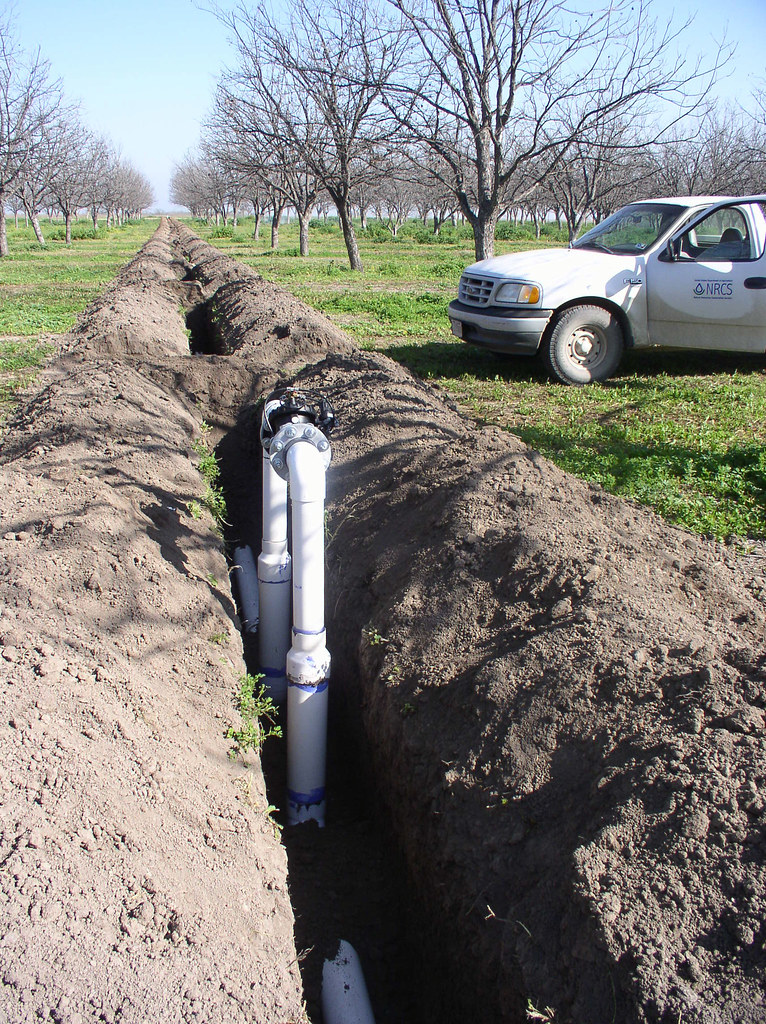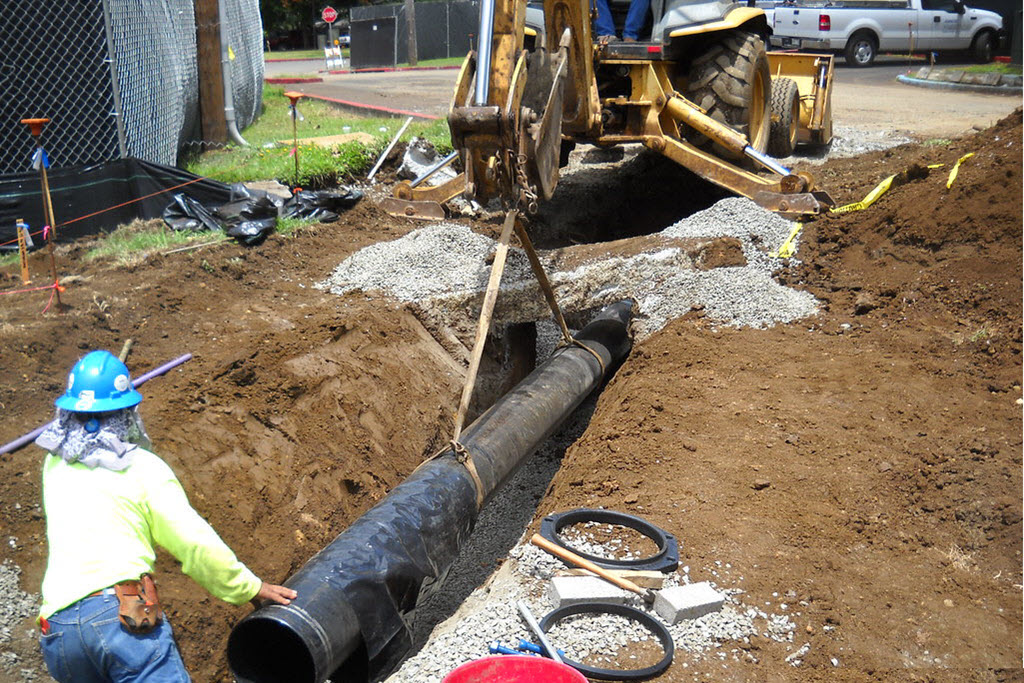Trenching Water Line Servicesin Center Line MI
Trenching for Water Lines to Ensure Reliable Water Flow
We Are Locally Owned & Operated For Over 37 Years
Contact Us Today!
We Serve Businesses In And Around The Following Cities:
About Trenching Water Line Services
Introduction
Functionality meets necessity in the realm of infrastructure, particularly when it comes to commercial properties in Center Line city. One undeniable necessity for every building, regardless of its purpose or size, is the provision of water supply. It is here that the process of trenching for water lines blends innovation, sophistication, and functionality. As the foundation of every civilization, a consistent and reliable water supply proves its pertinence in our everyday lives.
Unveiling the Trench for Water Line process
Trenching for water lines involves excavating a path for the installation of water mains. This task requires expertise and a comprehensive understanding of underground utilities. Missteps during this phase can result in utility damages, disrupting service delivery or causing significant repair costs.
Employing precision in excavation work directly correlates with a safe and effective water main installation. Contractors like D&J Contracting demonstrate their firm grasp of the process, starting with marking out the path, conducting a thorough site survey to avoid underground obstacles, and finally, executing careful excavation following the pre-determined path for a smooth installing water service line process.
Benefits of Trenching for Water Lines
The benefits of a correctly executed trench for the water line process are manifold. For starters, the process helps ensure the longevity of the water main system. Trained professionals can install the line appropriately in the trench to prevent damages, leaks, or unforeseen disruptions.
The process also ensures regulatory compliance. Water service lines run subject to local, regional, and national regulations regarding depth, materials, and methods of installation. Skilled contractors like D&J Contracting always display adherence to these standards. Hence, a proper trench for water line process guarantees compliance and wards off potential fines or penalties that arise from violations.
Applying Trenching for Water Line to Real-World
Installing or upgrading water lines in commercial spaces is tangible proof of the Trench for Water Line process in action. Whether it involves retrofitting an old building in Center Line city with a new water line or initiating a building’s setup from scratch, the necessity for the trench for water line remains consistent.
For instance, consider the project of expanding an existing commercial facility. While expanding the structure, the property management likely requires running a new water line to cater to the additional square footage. Companies like D&J Contracting could dig the trench, install the new water line, and prepare it for a seamless connection with the existing system.
Similar scenarios play out in new building projects where any water service line installation depends on the successful execution of the Trench for Water Line process. Of course, the quality and compliance of the task will determine the sustainability of the water supply course and the building’s prospective occupants’ quality of life.
Conclusion
In conclusion, the trenching process for water lines is an integration of different skill sets aimed at providing effective, long-lasting, and safe water delivery in commercial spaces. The procedure calls for trained and experienced hands to provide skillful navigation while adhering to precise specifications and regulations. The importance of the trench for water line process cannot be overemphasized in our societal fabric, primarily in a city like Center Line for commercial properties. Businesses, by utilizing services from trusted companies such as D&J Contracting, can ensure a smooth and seamless water line installation.
For an infrastructure necessity so vital, the Trench for Water Line process provides a quintessential blend of innovation, functionality, and necessity. Ensuring that it is carried out accurately and professionally not only safeguards a building’s water supply but also guarantees the health and well-being of its occupants, a goal we all strive towards in our civilized society.
Trenching Water Line Services Gallery


Call Us Today to receive your Free Quote for
Trench For Water Line in Center Line
Serving: Center Line, Michigan

About Center Line, Michigan
Historically, the land that Center Line came to occupy was swamp and wilderness until the early nineteenth century. As land became scarce, French, German, Belgian, and Irish immigrants began clearing the forests and draining the swamps. Center Line was known as “Kunrod’s Corner” during the mid-nineteenth century. The theory is that the French named it “Center Line” because it was the middle of three Potawatomi trails from Fort Detroit to northern trading posts. The “center line” was the trail used from Detroit to Utica. The community received its initial start when Catholics decided to build a church so that they would not have to walk to St. Mary’s in Detroit for Sunday Mass. This church (St. Clement’s) was established in 1854 and attracted more Catholic settlers into the area. In 1863, the first general store was constructed by Joeseph Buechel. On July 19, 1878, Hieronymous Engelmann was the first postmaster, and he was succeeded in 1885 by Sophia Buechel. The “Centre Line” post office closed on July 31, 1906, and the name was restored to Center Line thereafter. In this era, street car tracks connected Detroit to Center Line along Van Dyke Road, and Ten Mile Road was the final stop of the street car. The village was incorporated in 1925 in the center of Warren Township, which is now the city of Warren, and was incorporated as a city in 1936.
Center Line is in southwestern Macomb County and is surrounded entirely by the city of Warren. It is 11 miles (18 km) north of downtown Detroit, 7 miles (11 km) west of St. Clair Shores, 6 miles (10 km) east of Royal Oak, and 11 miles (18 km) south of Utica. Interstate 696 runs along the northern edge of Center Line, with access from Exits 22 through 24. Highway M-53 (Van Dyke Avenue) runs north-south through the center of town, connecting Detroit and Utica.
According to the U.S. Census Bureau, the city of Center Line has a total area of 1.75 square miles (4.53 km), all land.
| Census | Pop. | Note | %± |
|---|---|---|---|
| 1930 | 2,604 | — | |
| 1940 | 3,198 | 22.8% | |
| 1950 | 7,659 | 139.5% | |
| 1960 | 10,164 | 32.7% | |
| 1970 | 10,379 | 2.1% | |
| 1980 | 9,293 | −10.5% | |
| 1990 | 9,026 | −2.9% | |
| 2000 | 8,531 | −5.5% | |
| 2010 | 8,257 | −3.2% | |
| 2020 | 8,552 | 3.6% | |
| U.S. Decennial Census | |||
As of the census of 2010, there were 8,257 people, 3,632 households, and 1,988 families residing in the city. The population density was 4,745.4 inhabitants per square mile (1,832.2/km). There were 3,920 housing units at an average density of 2,252.9 per square mile (869.8/km). The racial makeup of the city was 82.5% White, 12.0% African American, 0.4% Native American, 2.5% Asian, 0.1% from other races, and 2.5% from two or more races. Hispanic or Latino of any race were 1.7% of the population.
There were 3,632 households, of which 27.7% had children under the age of 18 living with them, 32.0% were married couples living together, 17.5% had a female householder with no husband present, 5.2% had a male householder with no wife present, and 45.3% were non-families. 40.2% of all households were made up of individuals, and 18.1% had someone living alone who was 65 years of age or older. The average household size was 2.22 and the average family size was 3.01.
The median age in the city was 41.2 years. 21.4% of residents were under the age of 18; 8.2% were between the ages of 18 and 24; 25.1% were from 25 to 44; 27.5% were from 45 to 64; and 17.7% were 65 years of age or older. The gender makeup of the city was 46.1% male and 53.9% female.
85.9% of residents 25 or older hold a high school degree. 10.8% of residents 25 or older hold a bachelor’s degree or higher. Median household income was $30,752. 21.3% of the population lives below the federal poverty line.
As of the census of 2000, there were 8,531 people, 3,821 households, and 2,074 families residing in the city. The population density was 4,912.6 inhabitants per square mile (1,896.8/km). There were 3,916 housing units at an average density of 2,255.0 per square mile (870.7/km). The racial makeup of the city was 93.82% White, 3.09% African American, 0.25% Native American, 1.01% Asian, 0.26% from other races, and 1.57% from two or more races. Hispanic or Latino of any race were 1.51% of the population.
There were 3,821 households, out of which 24.2% had children under the age of 18 living with them, 36.8% were married couples living together, 13.7% had a female householder with no husband present, and 45.7% were non-families. 40.9% of all households were made up of individuals, and 22.5% had someone living alone who was 65 years of age or older. The average household size was 2.18 and the average family size was 2.99.
In the city, the population was spread out, with 21.8% under the age of 18, 6.9% from 18 to 24, 28.5% from 25 to 44, 20.5% from 45 to 64, and 22.4% who were 65 years of age or older. The median age was 40 years. For every 100 females, there were 81.5 males. For every 100 females age 18 and over, there were 75.5 males.
The median income for a household in the city was $31,677, and the median income for a family was $47,241. Males had a median income of $39,947 versus $26,487 for females. The per capita income for the city was $19,066. About 10.6% of families and 13.3% of the population were below the poverty line, including 17.9% of those under age 18 and 14.4% of those age 65 or over.
Most Center Line residents are zoned to schools in Center Line Public Schools, including Center Line High School. A small portion of the city is in Van Dyke Public Schools, served by Lincoln High School.<
St. Clement Catholic School, of the Roman Catholic Archdiocese of Detroit, was in Center Line. It was established in 1857. It had 110 students in the 2009-2010 year, and then 12 teachers and 89 students in its final year, 2010-2011. The parish decided to close the school as a parish takes a greater share of the costs if the number of students is under 100.
The archdiocese operated St. Clement High School in Center Line. It closed in 2005. Macomb Christian Schools (MCS) occupied the old St. Clement High School building from 2017 until 2019, when MCS shutdown.
Call Us Today to receive your Free Quote for
Trench For Water Line in Center Line
Related Services in Center Line, Michigan
We Serve Businesses In The Following Zip Codes:
48007, 48015, 48021, 48026, 48035, 48036, 48038, 48042, 48043, 48044, 48045, 48046, 48047, 48048, 48050, 48051, 48066, 48071, 48080, 48081, 48082, 48083, 48084, 48085, 48088, 48089, 48090, 48091, 48092, 48093, 48098, 48099, 48225, 48230, 48236, 48310, 48311, 48312, 48313, 48314, 48315, 48316, 48317, 48318, 48397